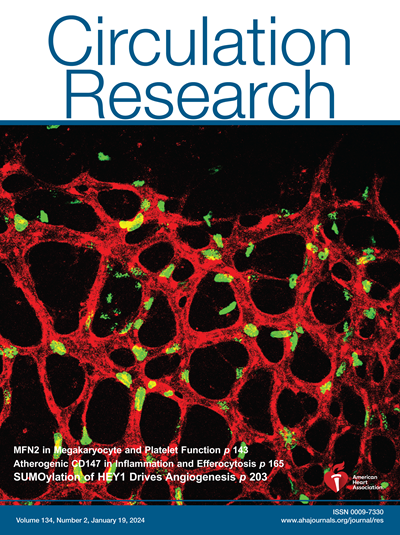心房颤动患者心房线粒体钙处理受损。
IF 16.2
1区 医学
Q1 CARDIAC & CARDIOVASCULAR SYSTEMS
引用次数: 0
摘要
背景:线粒体钙(Ca2+)是在负荷升高时通过刺激三羧酸循环来调节心脏能量的关键。心房颤动(AF)与胞浆内Ca2+瞬态振幅的降低有关,但其对线粒体Ca2+处理和细胞氧化还原状态的影响尚未在AF中探讨。方法从患者源性右心房活检中分离的心肌细胞使用膜片钳刺激和β-肾上腺素能刺激(异丙肾上腺素)进行负荷转换。同时,利用荧光显微镜监测NAD(P)H/黄素腺嘌呤二核苷酸自身荧光、胞质和线粒体[Ca2+]。使用电子断层扫描和受激发射耗尽显微镜对肌浆网和线粒体进行成像。研究了线粒体Ca2+摄取增强剂依折麦比对心房肌细胞心律失常前活动和患者心房颤动负担的影响。结果AF患者在增加负荷时线粒体Ca2+积累减弱,并与烟酰胺腺嘌呤二核苷酸和黄素腺嘌呤二核苷酸的再生受损有关。纳米尺度成像显示肌浆网和线粒体的空间紊乱,与微管不稳定有关。这在人类诱导的多能干细胞衍生的肌细胞中得到证实,其中诺可唑治疗取代线粒体并增加促心律失常的Ca2+火花,这些火花被MitoTEMPO拯救。依zetimibe还减少了心房颤动肌细胞和诺可达唑处理的人诱导多能干细胞来源的心肌细胞中致心律失常的Ca2+释放事件的发生。回顾性患者分析还显示,接受依折麦布治疗的患者心房颤动负担减轻。结论房颤患者心房肌细胞的线粒体Ca2+摄取和积累受损。由不稳定的微管驱动的肌浆网和线粒体之间的空间关联紊乱可能是房颤中Ca2+转移受损的基础。增强线粒体Ca2+摄取可能保护房颤患者免受心律失常事件的影响。本文章由计算机程序翻译,如有差异,请以英文原文为准。
Impaired Atrial Mitochondrial Calcium Handling in Patients With Atrial Fibrillation.
BACKGROUND
Mitochondrial calcium (Ca2+) is a key regulator of cardiac energetics by stimulating the tricarboxylic acid cycle during elevated workload. Atrial fibrillation (AF) is associated with a reduction in cytosolic Ca2+ transient amplitude, but its effect on mitochondrial Ca2+ handling and cellular redox state has not been explored in AF.
METHODS
Cardiac myocytes isolated from patient-derived right atrial biopsies were subjected to workload transitions using patch-clamp stimulation and β-adrenergic stimulation (isoproterenol). In conjunction, NAD(P)H/flavin adenine dinucleotide autofluorescence, cytosolic and mitochondrial [Ca2+] were monitored using epifluorescence microscopy. Sarcoplasmic reticulum and mitochondria were imaged using electron tomography and stimulated emission depletion microscopy. The effects of the mitochondrial Ca2+ uptake enhancer ezetimibe on proarrhythmic activity in atrial myocytes and on AF burden in patients were investigated.
RESULTS
Mitochondrial Ca2+ accumulation during increased workload was blunted in AF, and was associated with impaired regeneration of nicotinamide adenine dinucleotide and flavin adenine dinucleotide. Nanoscale imaging revealed spatial disorganization of sarcoplasmic reticulum and mitochondria, associated with microtubule destabilization. This was confirmed in human induced pluripotent stem cell-derived myocytes, where nocodazole treatment displaces mitochondria and increases proarrhythmic Ca2+ sparks, which were rescued by MitoTEMPO. Ezetimibe also reduced the occurrence of arrhythmogenic Ca2+ release events both in AF myocytes and nocodazole-treated human induced pluripotent stem cell-derived cardiac myocytes. Retrospective patient analysis also revealed a reduced AF burden in patients on ezetimibe treatment.
CONCLUSIONS
Mitochondrial Ca2+ uptake and accumulation are impaired in atrial myocytes from patients with AF. The disturbed spatial association between sarcoplasmic reticulum and mitochondria driven by destabilized microtubules may underlie impaired Ca2+ transfer in AF. Enhancing mitochondrial Ca2+ uptake potentially protects against arrhythmogenic events.
求助全文
通过发布文献求助,成功后即可免费获取论文全文。
去求助
来源期刊

Circulation research
医学-外周血管病
CiteScore
29.60
自引率
2.00%
发文量
535
审稿时长
3-6 weeks
期刊介绍:
Circulation Research is a peer-reviewed journal that serves as a forum for the highest quality research in basic cardiovascular biology. The journal publishes studies that utilize state-of-the-art approaches to investigate mechanisms of human disease, as well as translational and clinical research that provide fundamental insights into the basis of disease and the mechanism of therapies.
Circulation Research has a broad audience that includes clinical and academic cardiologists, basic cardiovascular scientists, physiologists, cellular and molecular biologists, and cardiovascular pharmacologists. The journal aims to advance the understanding of cardiovascular biology and disease by disseminating cutting-edge research to these diverse communities.
In terms of indexing, Circulation Research is included in several prominent scientific databases, including BIOSIS, CAB Abstracts, Chemical Abstracts, Current Contents, EMBASE, and MEDLINE. This ensures that the journal's articles are easily discoverable and accessible to researchers in the field.
Overall, Circulation Research is a reputable publication that attracts high-quality research and provides a platform for the dissemination of important findings in basic cardiovascular biology and its translational and clinical applications.
 求助内容:
求助内容: 应助结果提醒方式:
应助结果提醒方式:


